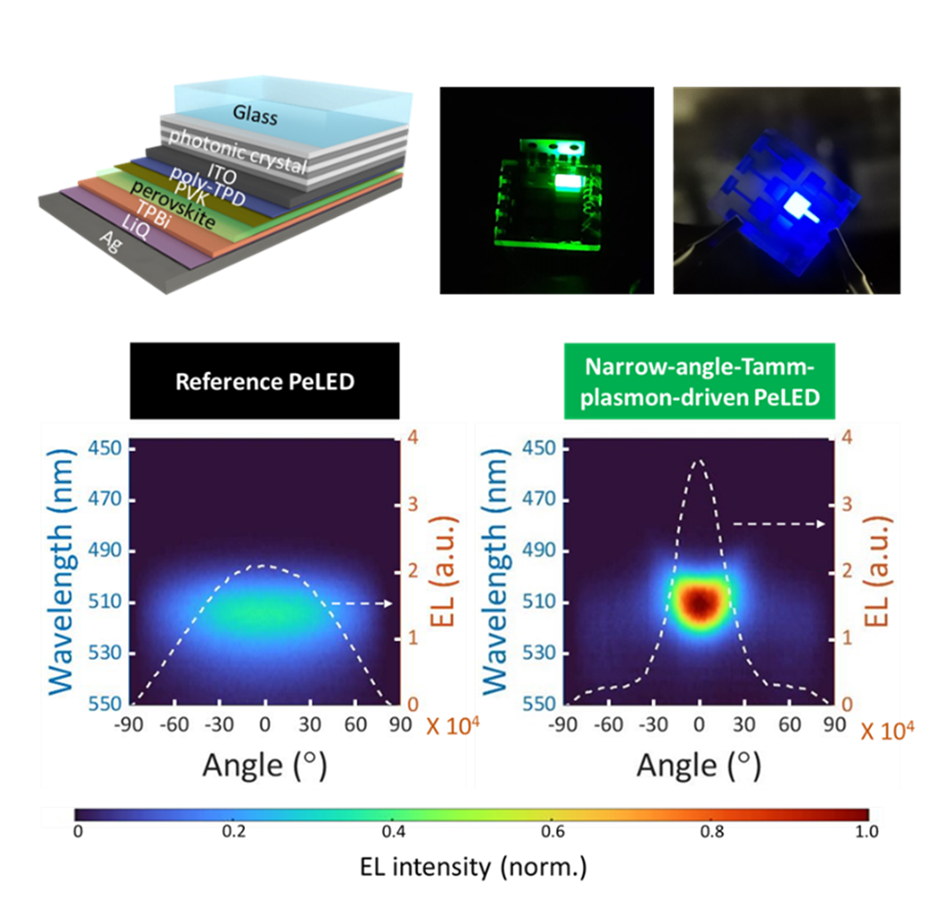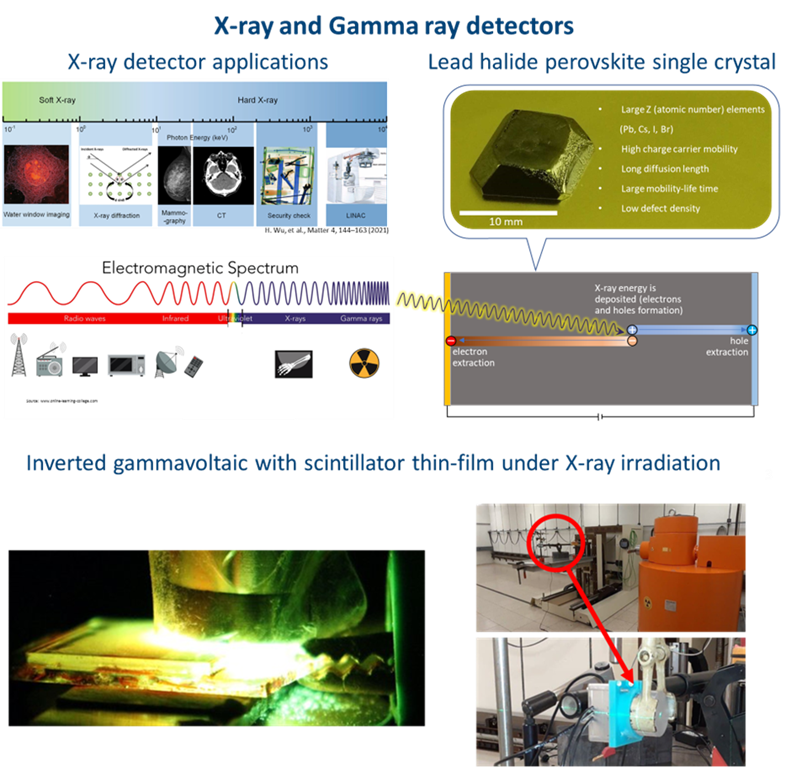Light Emission
The light-emission subgroup is involved in a diverse range of projects focused on exploring and advancing various aspects of perovskite-based light-emitting diodes (PeLEDs) and X-ray detection technologies. Their research encompasses both fundamental understanding and practical device applications. Here is an overview of the different projects within the group.
Perovskite light emitting diodes (PeLEDs)
We focus on the design, fabrication and characterisation of emerging light-emitting devices.
We employ advanced modelling tools to simulate light-matter interactions and find the best device architectures for PeLEDs along with optimizing the charge transport layer and composition of the perovskite layer for enhanced emission, better colour purity, control over directionality, white emission etc. By fine-tuning the composition of the perovskite layer and obtaining pure-phase quasi-two-dimensional perovskites, we aim to achieve efficient and stable PeLEDs. We also study the degradation mechanisms of PeLEDs during operation. We study the photophysics and electrical characteristics during operation, providing insights into the degradation processes. We employ advanced characterization techniques to investigate the device structure and optimize thin film fabrication protocols for improved performance. The subgroup utilizes a combination of diffraction, photoemission, and transient absorption techniques, including GIWAXS, XPS, HAXPES, photoluminescence (PL) spectrometer, transient absorption (TA) spectrometer, and UV-vis absorption spectrometer.
We interact closely with the materials and spectroscopy subgroups, making use of novel semiconductors and spectroscopic findings to fabricate devices with improved functionalities. Our approach seeks to find the optimum emitters in order to cover the entire visible spectrum, primarily blue, green, and red colours, with the ultimate goal of demonstrating efficient systems for white-lighting and sufficient light amplification for lasing. To this end, we have developed imaging tools that allow us to identify and quantify electroluminescence heterogeneities on the nanoscale and compare those with their photoexcited counterparts. We also have a range of techniques to quantify photo- and electro-luminescence quantum yields and spectral features on both the macro- and micro-scale. These methodologies are key to understand the origin of performance losses and develop new strategies to overcome those losses.

Related Publications
- Ji, K. et al. Self-supervised deep learning for tracking degradation of perovskite light-emitting diodes with multispectral imaging. Nat. Mach. Intell. 2023 doi:10.1038/s42256-023-00736-z
- Sun, Y. et al. Bright and stable perovskite light-emitting diodes in the near-infrared range. Nature 2023, 615, 830–835
- Shamsi, J., Rainò, G., Kovalenko, M. V. & Stranks, S. D. To nano or not to nano for bright halide perovskite emitters. Nat. Nanotechnol. 2021, 16, 1164–1168
- Ji, K., Anaya, M., Abfalterer, A. & Stranks, S. D. Halide Perovskite Light‐Emitting Diode Technologies. Adv. Opt. Mater. 2021, 9, 2002128
- Andaji‐Garmaroudi, Z. et al. Elucidating and Mitigating Degradation Processes in Perovskite Light‐Emitting Diodes. Adv. Energy Mater. 2020, 10, 2002676
- Anaya, M. et al. Best practices for measuring emerging light-emitting diode technologies. Nat. Photonics 2019, 13, 818–821
- Stranks, S. D., Hoye, R. L. Z., Di, D., Friend, R. H. & Deschler, F. The Physics of Light Emission in Halide Perovskite Devices. Adv. Mater. 2019, 31, 1803336
X-ray detection
The subgroup utilizes the versatile FLS-1000 Edinburgh spectrometer for various applications. It goes beyond photoluminescence (PL) and time-resolved PL measurements at different temperatures. Equipped with both continuous wave (CW) and pulsed X-ray sources, it facilitates the measurement of radioluminescence (RL) and time-resolved RL (scintillation). Additionally, by connecting devices electrically, we assess the performance of direct X-ray detectors.
We employ highly luminescent perovskite nanocrystals as X-ray and radiation scintillators. The research involves synthesizing advanced composites, assembling complex architectures, and characterizing the structural and photophysical properties of these X-ray detectors and other novel energy harvesting platforms..
In our pursuit of X-ray detection advancements, we investigate a novel approach by combining metal-organic frameworks (MOFs) and halide perovskites. This fusion aims to leverage the beneficial properties of both compounds. Our research encompasses the synthesis of advanced composites, the assembly of complex architectures, and the fundamental characterization of these X-ray detectors.
We also focus on perovskites as alternative materials for X-ray photon counting detectors (PCDs). Capitalizing on their excellent mobility-lifetime products, high stopping power, and low detectable dose, we strive to develop multi-pixelated X-ray PCDs using high-quality and cost-effective perovskite single crystals.
Overall, the subgroup demonstrates a multidisciplinary approach encompassing materials synthesis, device fabrication, advanced characterization techniques, and fundamental understanding to advance the field of perovskite-based LEDs and X-ray detection technologies.

Related Publications
- Moseley, O. D. I., Doherty, T. A. S., Parmee, R., Anaya, M. & Stranks, S. D. Halide perovskites scintillators: unique promise and current limitations. J. Mater. Chem. C 2021, 9, 11588–11604
- Ferrer Orri, J. et al. Unveiling the Interaction Mechanisms of Electron and X‐ray Radiation with Halide Perovskite Semiconductors using Scanning Nanoprobe Diffraction. Adv. Mater. 2022, 34, 2200383
